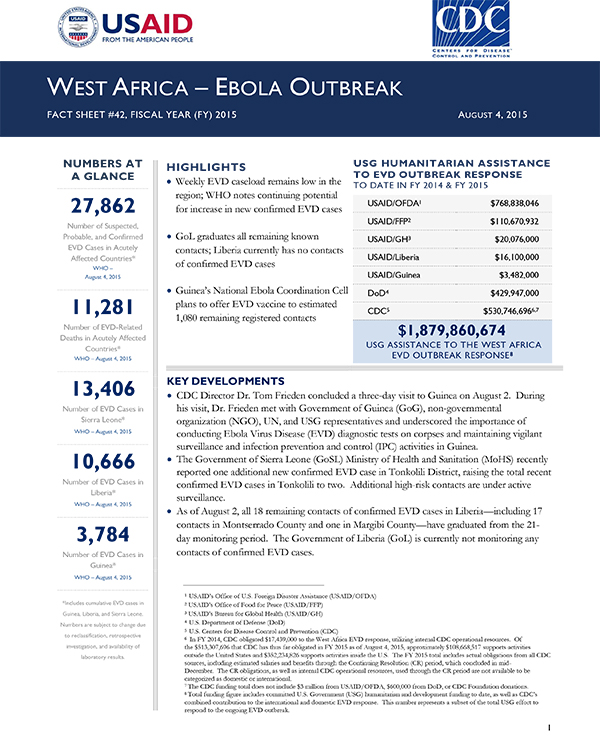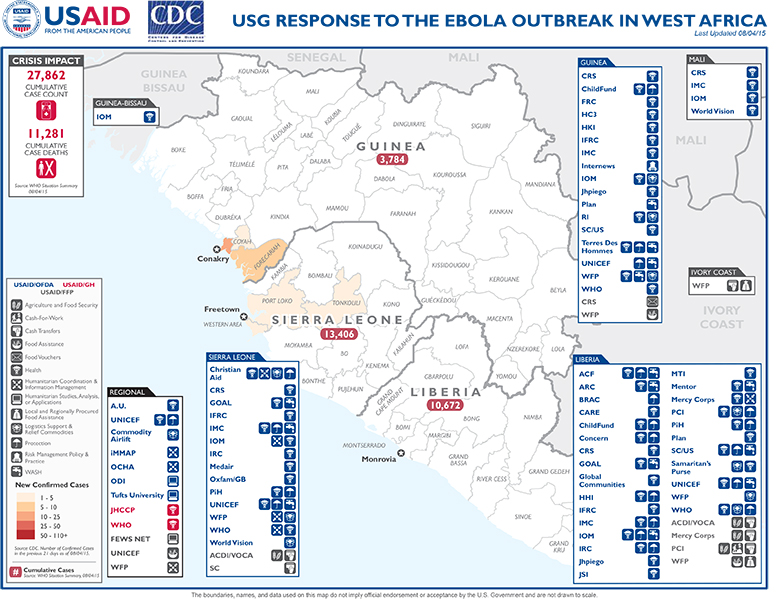August 4, 2015
HIGHLIGHTS
Ebola Response
Visit our main West Africa Ebola Outbreak page to learn more about how we're responding to the West Africa Ebola outbreak, and what you can do to help.
- Weekly EVD caseload remains low in the region; WHO notes continuing potential for increase in new confirmed EVD cases
- GoL graduates all remaining known contacts; Liberia currently has no contacts of confirmed EVD cases
- Guinea’s National Ebola Coordination Cell plans to offer EVD vaccine to estimated 1,080 remaining registered contacts
West Africa Fact Sheet #42 - 08-04-2015 ![]() (pdf - 369k)
(pdf - 369k)
KEY DEVELOPMENTS
- CDC Director Dr. Tom Frieden concluded a three-day visit to Guinea on August 2. During his visit, Dr. Frieden met with Government of Guinea (GoG), non-governmental organization (NGO), UN, and USG representatives and underscored the importance of conducting Ebola Virus Disease (EVD) diagnostic tests on corpses and maintaining vigilant surveillance and infection prevention and control (IPC) activities in Guinea.
- The Government of Sierra Leone (GoSL) Ministry of Health and Sanitation (MoHS) recently reported one additional new confirmed EVD case in Tonkolili District, raising the total recent confirmed EVD cases in Tonkolili to two. Additional high-risk contacts are under active surveillance.
- As of August 2, all 18 remaining contacts of confirmed EVD cases in Liberia—including 17 contacts in Montserrado County and one in Margibi County—have graduated from the 21- day monitoring period. The Government of Liberia (GoL) is currently not monitoring any contacts of confirmed EVD cases.
REGIONAL
In its most recent situation report covering the period from July 20–26, the UN World Health Organization (WHO) reported seven confirmed cases of EVD in West Africa, including four cases in Guinea and three cases in Sierra Leone. The weekly total represents the lowest weekly caseload in the region in more than one year. WHO reports that while the decline in cases is encouraging, more than 2,000 contacts remain within the 21-day monitoring period in the region, indicating a strong potential for a near-term increase in new confirmed EVD cases. For the third consecutive week, the majority—more than 71 percent—of new EVD cases originated in Conakry and Freetown, the capital cities of Guinea and Sierra Leone, respectively.
Between July 20 and 26, one of the seven newly confirmed cases in the region originated from an unknown source of infection; the other six EVD-positive cases were found among known contacts. One of the cases—from Guinea—was a health care worker. As of July 26, the governments of Guinea, Liberia, and Sierra Leone had reported a total of 880 confirmed infections among health care workers, including more than 500 related deaths.
From July 20–22, WHO hosted a regional meeting in Liberia’s capital city of Monrovia on the ring IPC approach, which prioritizes assessments of health facilities in the areas surrounding the residences of confirmed EVD cases. The meeting—which included representatives of the governments of Guinea, Liberia, and Sierra Leone—recommended establishing shared IPC and water, sanitation, and hygiene (WASH) standards implemented by an independent regulatory body, creating a data collection and sharing platform, and developing mechanisms for inter-country collaboration on related issues, among others.
West Africa Map - 08-04-2015 ![]() (pdf - 593k)
(pdf - 593k)
Liberia
The GoL reported zero new EVD cases from July 31–August 2. As of August 2, all 18 remaining contacts of confirmed EVD cases in Liberia—including 17 contacts in Montserrado and one in Margibi—had graduated from the 21-day monitoring period. The GoL is not currently monitoring any contacts of confirmed EVD cases. CDC and USAID/OFDA partners—including Concern Worldwide, Global Communities, International Medical Corps (IMC), International Rescue Committee (IRC), Save the Children/U.S. (SC/US) and the UN Children’s Fund (UNICEF)— continue to support EVD preparedness and risk mitigation activities in Margibi and Montserrado counties.
Liberia’s last four confirmed EVD cases were discharged as survivors from the ELWA 3 EVD treatment unit (ETU) on July 20 and 23. During the week ending August 2, the four recently released survivors participated in the WHO- and CDC-supported GoL men’s health screening program. The four men provided samples for semen testing and received counseling; to date, the GoL, WHO, and CDC have enrolled 60 male EVD survivors in the program, which includes EVD testing and survivor counseling. Of those, 26 survivors have participated in follow-up visits, receiving test results and psychosocial counseling, as needed.
On July 29, the GoL Incident Management System (IMS) relocated Liberia’s national call center from the country’s former emergency operations center (EOC), established in October 2014, to its permanent home at Liberia’s new EOC. The new EOC, which became operational in early June 2015, was established adjacent to the GoL Ministry of Health in Montserrado to support its capacity to manage public health emergencies. The call center answers all EVDrelated calls to the national 4455 hotline, and dispatch services in response to calls reporting EVD cases or dead bodies. Since August 2014, more than 150,000 people have used the 4455 hotline to report suspected cases of EVD.
Sierra Leone
As of August 3, the National Ebola Response Center (NERC) had reported that there are no missing contacts identified in connection to the one new confirmed EVD case in Sierra Leone between July 27 and August 2. The Government of Sierra Leone (GoSL) Ministry of Health and Sanitation (MoHS) recently reported one additional new confirmed EVD case in Tonkolili District and noted additional high-risk contacts are under active surveillance.
Between August 3 and 4, USG Disaster Assistance Response Team (DART) staff attended a two-day WHO-sponsored conference on clinical care for EVD survivors in Sierra Leone’s capital city of Freetown. Nearly 100 participants— including EVD survivors from Guinea, Liberia, and Sierra Leone and representatives from UN agencies and NGOs— attended the conference. In addition to providing a forum for EVD survivors to articulate the unique challenges faced during recovery, a primary objective of the conference was to reach consensus on different aspects of managing clinical care for EVD survivors, particularly sexual and reproductive health issues. Conference participants expressed a need to develop guidance for the maternal and neonatal care of EVD survivors. During the conference, EVD survivors recounted several challenges faced during and after convalescence, including adverse psychological effects, community stigmatization and re-integration difficulties, diminished livelihoods, and persistent physical pain.
Guinea
During the week ending August 2, the Government of Guinea (GoG) reported only one confirmed EVD case. The case—a registered contact from Conakry’s Ratoma sub-prefecture—had been missing for approximately two weeks. Surveillance teams located the woman on July 31 and subsequently transferred her to Conakry’s Nongo ETU.
On August 3, the National Ebola Coordination Cell reported that all remaining contacts in Conakry’s Matam subprefecture and Fria Prefecture had graduated from observation in recent days. As of August 2, 18 suspected and confirmed EVD patients were receiving care at ETUs throughout Guinea. Of these, the Nongo ETU was treating 13 EVD-positive patients and four suspected EVD cases, while the ETU in Forécariah was caring for one suspected EVD case.
On August 3, the National Ebola Coordination Cell announced plans to offer the EVD vaccine to an estimated 1,080 registered contacts remaining in Guinea.
CDC Director Dr. Tom Frieden concluded a three-day visit to Guinea on August 2. During his visit, Dr. Frieden met with GoG, NGO, UN, and USG representatives to discuss EVD response priorities and long-term strategies to reinforce Guinea’s health care system and support EVD survivors. Dr. Frieden also conducted visits to the Nongo ETU, the U.S. Defense Threat Reduction Agency diagnostic laboratory, one of Conakry’s community-level EOCs, and Conakry’s health directorate. While in Guinea, the CDC Director stressed the importance of maintaining vigilant surveillance and IPC activities.
On July 29, the DART accompanied staff from USAID/OFDA partner UNICEF to observe social mobilization activities in Conakry’s Kaloum, Matam, and Ratoma sub-prefectures. The DART’s visit to Matam included a briefing by the sub-prefecture’s health directorate and coordination cell on new strategies employed during the micro-cerclage, or defacto quarantine. DART staff also visited Conakry’s primary fishing port, Matam’s main taxi park, as well as Boussoura―one of the two neighborhoods in Matam that is currently under quarantine.
With USAID/OFDA support, the International Organization for Migration (IOM) continues efforts to equip and improve the capacity of prefectural EOCs (PEOCs) throughout Guinea. On July 10, IOM began rehabilitation work―including infrastructure renovation and the procurement and installation of office supplies, internet, and a power supply―on three new PEOCs in Boké, Fria, and Télimélé prefectures. Since the start of the EVD outbreak, IOM has equipped and renovated 25 emergency operation centers (EOCs) countrywide, including five community-level EOCs in Conakry
PUBLIC DONATION INFORMATION
- The most effective way people can assist relief efforts is by making cash contributions to humanitarian organizations that are conducting relief operations. A list of humanitarian organizations that are accepting cash donations for disaster responses around the world can be found at www.interaction.org.
- USAID encourages cash donations because they allow aid professionals to procure the exact items needed (often in the affected region); reduce the burden on scarce resources (such as transportation routes, staff time, and warehouse space); can be transferred very quickly and without transportation costs; support the economy of the disaster-stricken region; and ensure culturally, dietary, and environmentally appropriate assistance.
More information can be found at:
- The Center for International Disaster Information: www.cidi.org or +1.202.821.1999.
- Information on relief activities of the humanitarian community can be found at www.reliefweb.int.
USAID/OFDA bulletins appear on the USAID website at what-we-









Comment
Make a general inquiry or suggest an improvement.